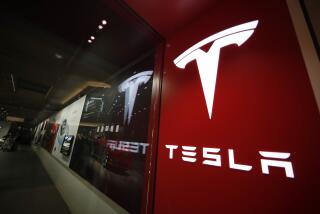A Musk failure or a respectable near-miss? Tesla releases Model 3 production numbers

- Share via
Reporting from San Francisco — The Model 3 production numbers released by Tesla on Tuesday are being greeted as a failure by critics and as a respectable near-miss by fans.
The company has targeted 2,500 cars a week by the end of March, and managed to reach 2,020. For the full quarter, Model 3 production hit 9,766 cars.
But there was a lot more news contained within the company’s production and delivery report that may prove more important.
- Deliveries of the company’s luxury Model S and Model X cars nosedived, down about 23% from the fourth quarter, to 11,730 and 10,070 vehicles respectively. Tesla said it is limiting production of the Model S and Model X this year to 100,000 cars, about the same as last year. It’s unclear whether that is due to flat demand, an attempt to lower costs and boost gross profit margins, or both.
- Tesla said rapidly increasing Model 3 production is “laying the groundwork for Q3 to have the long-sought ideal combination of high volume, good gross margin and strong positive cash flow.” With expected operating losses of $900 million for the first quarter to be reported next month, that looks like a stretch. But it sets a new and highly ambitious hard date for success that, if met, could send its suffering stock soaring again — and if not, could mean big paydays ahead for legions of Tesla short sellers, who profit when the stock price declines.
- Despite a recent bond downgrade over concerns about cash flow, the company said that because the third quarter will perform so well, “Tesla does not require an equity or debt raise this year.” Critics responded by reposting a 2012 tweet from Chief Executive Elon Mush that said “Tesla does not need to ever raise another funding round” with a list of subsequent debt and equity rounds that raised $8.96 billion.
Bond rating firm Moody’s said last month that Tesla will need to raise billions later this year or early next if it doesn’t severely curtail capital spending. Efraim Levy, a stock analyst at CFRA, said there’s no question Tesla will need to raise more money. He said he’s “skeptical” about positive operating cash flow this year. “They might be able to pull it off as a onetime thing” for a single quarter, he said.
Tesla’s Tuesday report also said that Model 3 reservations have “remained stable” through the first quarter, but offered no figures. The last time the company quantified Model 3 reservation numbers was last July: 455,000 of them.
On Tuesday, the company said any order cancellations “are almost entirely due” to delays in production and delays in an all-wheel drive model and the long-promised $35,000 base price Model 3. The base price for Model 3s being sold today is $49,000 and fully loaded models top $60,000.
Tesla stock was up Tuesday about 6.5% at 11 a.m., to about $270. That’s down about 30% from an all-time high of $383.45 in June.
Musk originally planned to be building 500,000 cars a year in 2018 at its Fremont, Calif., assembly plant, the vast majority of them Model 3s. Even if Tesla hits all its current targets, no more than 150,000 Model 3s will be produced this year.
That’s far more cars than any automobile start-up has pumped out since the early days of the auto industry. The question for investors is whether Musk can make money on them. The 15-year-old company has never earned an annual profit and continues to burn cash in pursuit of growth.
Short sellers never believed Tesla could earn profits even at 500,000 cars a year. That can’t yet be proved either way, but Tesla must fix serious manufacturing problems — “production hell” in Musk’s own words — to stand a chance.
Bernstein stock analyst Max Warburton recently issued a detailed report that Musk’s attempt to automate his factories has been far too aggressive and is the prime cause of Tesla’s production and quality problems.
While appreciating Musk’s ambition and technical acumen — “who is not impressed” by watching a Space X booster land back on Earth, he wrote — Warburton said “Tesla may ultimately need to fundamentally rethink Fremont. … This may require the product itself to be redesigned as well.”
Underlining the notion that production problems have not been solved, Musk is devoting more time to manufacturing issues. The Information reported that Chief Engineer Doug Field has been, in effect, shunted aside. Tesla denied that and said Musk is fulfilling his responsibilities as CEO, turning his attention where it’s most needed.
Musk himself ripped into the author of the article on Twitter, drawing strong support (and a few brickbats) from Tesla supporters.
Field had sent a memo to Tesla workers last month exhorting them to boost production and prove “haters” wrong.
If Tesla pushed its workers too hard to bang out enough cars to meet Musk’s 2,500-a-week target, the results could be costly, to the bottom line and to the Model 3’s reputation, as service centers are swamped with repairs as those cars hit the market.
Although most professional car reviewers love the way the Model 3 drives, online Tesla forums are rife with quality complaints, including about bad fit and finish, dead batteries and instructions from customer support to keep rebooting the car to get it started.
But Tesla said in its Tuesday report that customers express “overwhelming delight” with the Model 3 and the company’s “initial customer satisfaction score” is 93%.
Delighted customers or not, Tesla will need more capital to keep going.
“This is a company about growth, and growth needs financing,” said CreditSights analyst Hitin Anand, who estimates that Tesla will have to raise about $2 billion in the next six months, probably through a combination of equity and convertible debt. “You got lucky the first time around,” on the unsecured bond sale, Anand said. “If you test the market a second time and it fails, that loses confidence and hurts the equity even more.”
Philippe Houchois, an analyst at Jefferies Group who upgraded his recommendation on the shares to “hold” from “underperform” on Monday, sees Tesla skewing the mix of funds more toward equity than debt in its next capital raise. In an interview on Bloomberg Radio, Houchois said he expects Tesla will need $2.5 billion to $3 billion to fund the ramp-up of Model 3 production, with shareholders suffering some dilution as a result.
“Raising capital in those circumstances with what’s happening on the bond side isn’t easy,” Houchois said.
Not that an equity raise, or convertible debt offering, would be easy either.
Tesla’s stock is fresh off one of its worst months ever. Some of Tesla’s convertible bonds are now trading below par, a sign that investors are valuing the securities less like equity, said Peter Tchir, head of macro strategy for Academy Securities Inc. The scrutiny from fixed-income investors could blunt Musk’s persuasive powers that helped sell the last bond issue.
“Credit is not a game,” Tchir said on Bloomberg Television on Monday. “This is going to be who comes and takes you to task for your mistakes.”
Moody’s now rates Tesla as B3, five steps above default, with a negative outlook.
The Associated Press and Bloomberg were used in compiling this report.
UPDATES:
12:05 p.m.: This article was substantially updated with new reporting and additional analysis.
7:40 a.m.: This article was updated with analysis of Tesla’s financing options.
This article was originally published at 7:25 a.m.
More to Read
Inside the business of entertainment
The Wide Shot brings you news, analysis and insights on everything from streaming wars to production — and what it all means for the future.
You may occasionally receive promotional content from the Los Angeles Times.











